Pinnacle Arkose Alfine 8
- Price: £1000
- From: Evans
- Size tested: Medium
- Weight: 10.48kg
- Tested for: 3 months
We’ve played out before on an earlier Arkose Two, plus the blinged up LTD edition, so to some extent getting this bike in to test was about seeing what the Shimano Alfine hub would be like on a gravel bike. We were pretty confident that the rest of the Arkose 8 would be sorted – as we’ve come to expect from Evans’ in-house brand. Under the stewardship of designer James Olsen, Pinnacle has become a brand with a reputation for understated but highly functional bikes offering good value for money with decent style points. The Alfine hub seemed like a potential great addition to a burly commuter bike or adventure explorer – everything nicely sealed away from grit and grime and promising a more weather proof option than perhaps a standard rear derailleur gearing. So would this be the case? It has basically rained, snowed, or been at sub zero temperatures for the whole time that I’ve had this test bike, so it’s certainly be put to the test. But before I tell you how the gears have fared, let’s look at the rest of the bike.
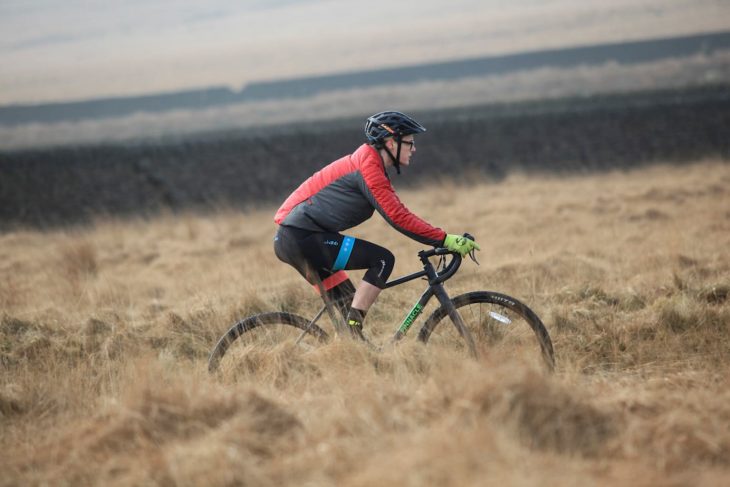
The Arkose Alfine 8 sits within a 2018 range of nine current models, including three ‘women’s specific’ options, at prices from £875 up to £1,350. The Arkose Alfine 8 sits somewhere in the middle. At the same price point of £1,000 there is a Arkose 2 which comes kitted out with Shimano Tiagra gears. The impact of the extra cost of the Alfine 8 is apparent in the differences in some of the component choices between the two: the Arkose 8 gets TRP brakes instead of Shimano, and doesn’t have tubeless ready or compatible wheels and tyres.
In fairness, the TRP Hylex brakes are excellent. I’ve used them before and found them to be reliable and have no concerns about having them instead of Shimano branded versions. Indeed, they’ve proved reliable again during the test period, although they did develop an annoying rattley waggle in the levers that I’ve not experienced before. It doesn’t seem to affect the performance, it just makes a bit of a noise on rough trails.
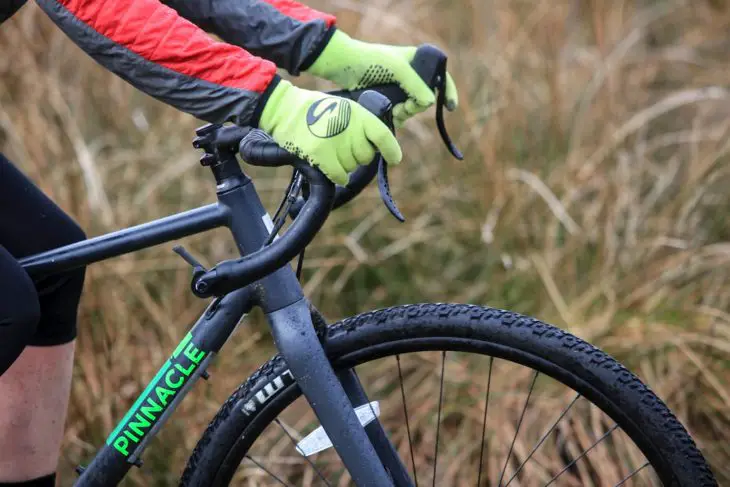
The WTB Nano Comp tyres are also excellent. They’ve been out in mud, on wet gritstone and setts, tarmac, slush, deep snow. Really the only the thing that defeated them was sheet ice – but nothing short of ice spikes is going to handle that. Such was the confidence inspiring grip of the Nanos that my husband poached the bike off me for the worst weather commutes. His commute is both longer and more exposed than mine, so, being a kindly wife, I let him take the Arkose instead of his usual gravel bike. In full on wintry conditions riding up a series of steep climbs and down descents, he only had to dismount to help push some motorists who had got stuck in the drifts. Otherwise, the Nanos gripped really well. They’re also not too draggy on the road, especially when given a decent amount of pressure, although if you were only going to ride this bike on the road you might want to swap them for something slicker. But then, why would you be buying this bike? Off road is where the fun is!
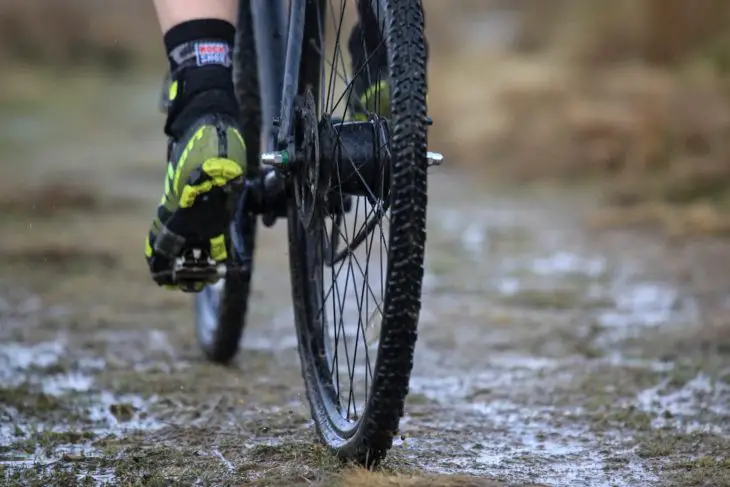
I did however miss the supple feel of other tubeless tyres I’ve used, and while I didn’t puncture, I did run these tyres firmer than was ideal for fear of getting a pinch flat. Risking a lower pressure for a few less aggressive rides, the difference in comfort was noticeable. Given that from the Arkose X and up, wheels are tubeless compatible, this is food for thought for those wondering whether the Arkose Alfine 8 model is the right one for you – neither rims nor tyres are tubeless compatible on it. I’m going to come back to this later…
I hesitate to use the word ‘cockpit’ because I’m no fighter pilot, but the bar/stem/spacers/steerer tube proportions felt just right to me. I’m 5 foot 9.5 and the medium frame felt just right to me, without any adjustments needed out of the box, save for an easy tweak to the reach on the brakes. A range of hand positions was comfortable on body, back and hands with no funny stretching, reaching or pinching between any of the angles. The black electrical tape holding the bar tape in place did start to split a little by the end of the test period, and I imagine it might feel a little scratchy to bare hands – however this has not been the season for testing this. If I had ridden without gloves, I wouldn’t be typing this now.
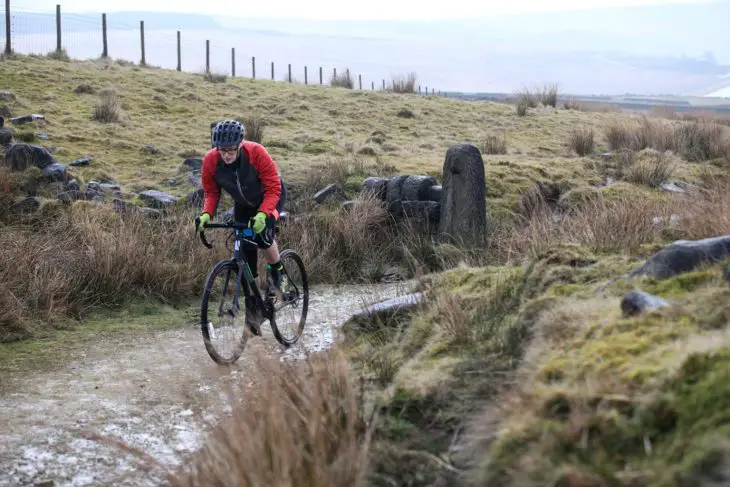
While the bars are comfortable, there is a fair amount of feedback through the frame, despite the carbon fork. You can improve the situation a lot by lowering tyre pressure, but that’s going to be up to you to decide how valuable ride comfort is compared to the risk of a puncture on whatever terrain you’re riding.
At the other end of the bike, I did swap out the saddle – it’s a personal choice, but I found the stock men’s saddle to be like sitting on a wedgie. A wider saddle with less of a curved profile solved this problem.
Cable routing is sensible, with no close interfaces risking frame rub. It’s also an impressively quiet ride and the cables aren’t rattling about anywhere. I’ve managed a couple of small chips and a few scratches, but on the whole the finish is good and I really like the minimal but contrasting decals.
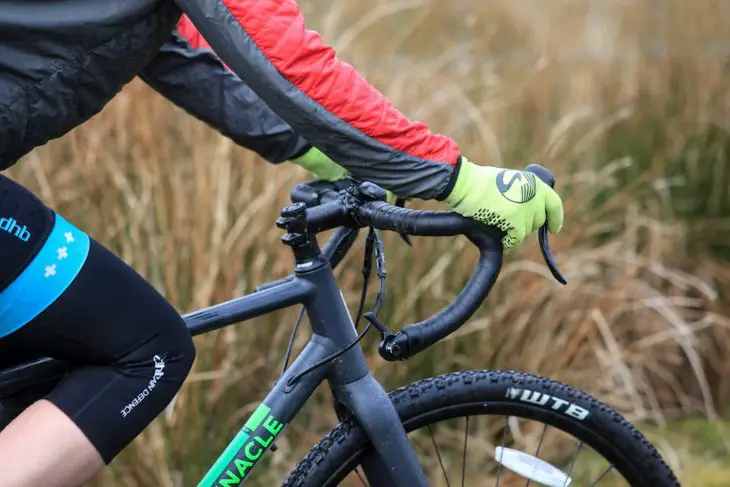
The eccentric bottom bracket needed adjustment towards the end of the test period in order to take up some of the slack that had developed in the chain. This proved to be a very simple job and wasn’t the tricky job a feared it might be. Obviously adjusting the bottom bracket also affects the height of the bottom bracket, but I didn’t have any trouble with pedal clipping in either position I rode the bike in. That said, I admit that a combination of weather, gearing, and fear of punctures has had me testing this bike in a somewhat less aggressive fashion than my usual gravel bike tests. But bearing in mind my usual habits are closer to what you might expect an XC mountain bike to cover and you should hopefully be reassured that this bike will handle the terrain that the majority of riders will attempt. Aside from the gears (just wait, I’m nearly there) the bike has held up really well to what has been truly filthy conditions. It’s also handled well in them – you’d have a job keeping up with a chain gang or racing ‘cross on it, but for most riders I think this bike will offer a perfectly satisfactory level of speed for the kind of riding it’s designed for.
On then, to those gears. Well. It’s been a learning experience, in a number of ways. I’ve not ridden an Alfine hub before, and have only limited experience with other hub gears. And others in the office aren’t too familiar with them either, so this next bit comes with that as context. Whereas with ‘standard’ gears, we’d be able to identify the cause of almost any issue, in this case, we can’t be quite so confident in our diagnosis. And the Alfine 8 did prove to be something of a poorly patient. However, just as it can be very hard to figure out whether your stiff neck is related to your tight glutes, or a completely separate issue, we’ve similarly struggled to separate out symptoms and causes. But one thing is clear: my hub was not watertight.
The not so good.
In the beginning, for about three weeks, things felt nice and smooth. Pedalling along was a pleasantly silten experience. And then I started to wonder what was wrong with my legs. Was I getting ill? Regular rides seemed to take a bit more effort. Were my brakes rubbing? A quick check in the garage revealed that my brakes weren’t rubbing, but my rear hub was sounding rather rumbly. The kind of rumbly you get when your bearings are swimming in rust soup rather than grease – anyone who’s tried to get just a few more rides out of a bottom bracket or cup and cone bearing will know exactly what I’m talking about.
Rumble grumble. Grumble rumble. I cleaned the bike in the hope that it was just a bit of mud somewhere, but no, something was definitely awry in the inside of the hub. Time to watch a series of YouTube videos of people taking apart and servicing Alfine hubs. There are a lot of bits in there. Some of them look like they’re the same on both sides – but they’re not. Put them back in the wrong way round and things won’t quite go back together properly, although of course you probably won’t discover that until you’ve put all the other bits in and it’s the last bit that won’t fit. Humph. Getting into those bits in the first place is quite the experience too – there’s a circlip that requires dentistry skills to get it off. And on again. In short, this was not a happy time for me in the workshop. And I spent quite a lot of time there.
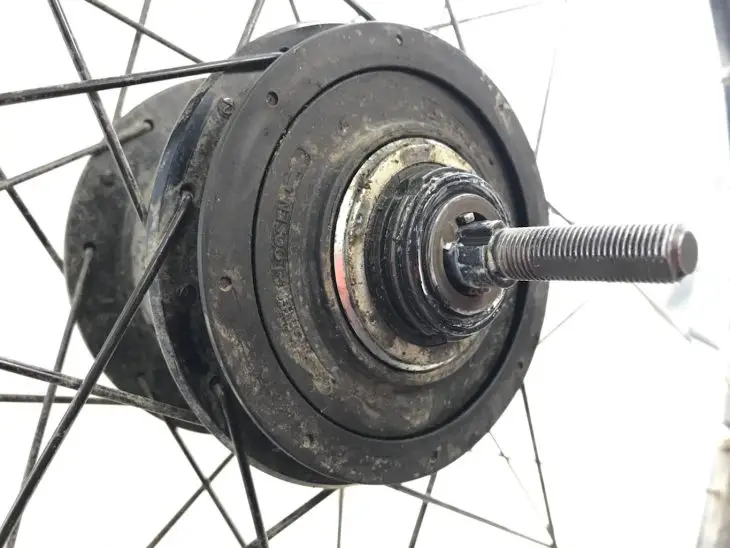
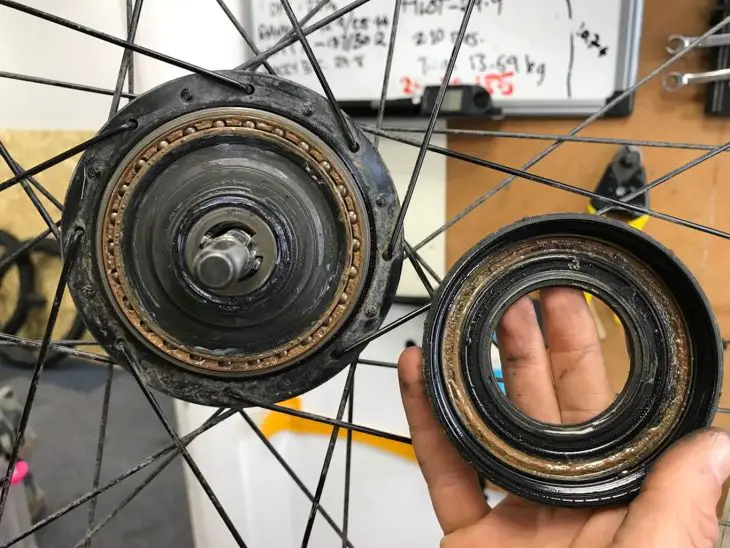
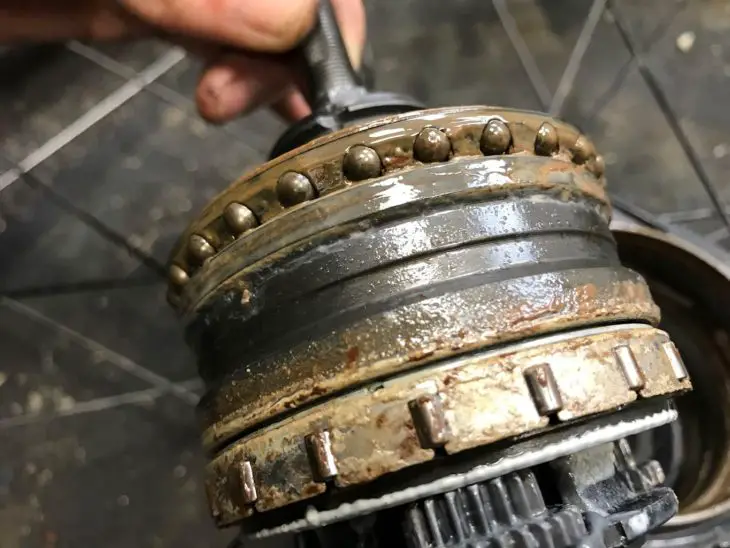
Finally peeling off the outer rings and exposing the inside of the hub revealed a steampunk nightmare in rust gravy. Ironman would have gobbled it up for Sunday lunch, using that hateful circlip for a toothpick once he was done. Bearings in races on either side of the hub were no longer greased up, and even after a good clean up the races were still somewhat pitted. There is a kit you can buy to properly flush through, service and regrease an Alfine hub, but you’re only supposed to have to do this after two years or two thousand miles. I’ve put the miles in on this, around 100km a week, but in four weeks even the joint efforts of me and my husband couldn’t come close to 2000 miles. So I didn’t give it the full oil dunk, but I did give it a good clean up and regrease, and put it back together again. It’s not a process I’d want to repeat very often. Changing jockey wheels, or cassettes, is a whole lot easier.
Anyway, depending on your mileage, you ought not need to do this after less than a month, and indeed Evans has confirmed that this would be eligible for a warranty replacement.
The known unknowns.
With this water penetration in mind, it’s a touch hard to judge the other issues I’ve had with the Alfine hub. Are they down to the poorly bearings, or a poor set up following my not-so-extensive hub maintenance knowledge? Certainly they have a reputation for being very sensitive to correct set-up, so it’s possible that something wasn’t just so. But whatever the cause, I experienced some disconcerting issues that made it hard to trust the hub.
As I was pedalling along, I’d suddenly find myself with no power at all. And then maybe half a pedal turn, or a full revolution later, power returns. Just cruising along, this is disconcerting, but not too much of a problem. If you’re just about to add a bit of power to get over a rock or trail obstacle, you might have a bit of a wobble, or a rapid unclipping. If you’re powering away from traffic lights, you can expect your crotch or knees to make rapid and painful contact with the bike. A bit of a hunt on the internet suggests that the sudden loss of traction I would get are related to the lockring on the hub – it unlocks momentarily, then slides back into place. Personally, I’d like my lockring to be…well, locked. As I said before, I can’t be 100% sure if this issue is down to the warrantable wear, poor set up, a bit of dirt in the wrong place, or some other cause. But whatever it is, it’s annoying and occasionally dangerous, and it would appear I’m not the first to experience it.
When it works.
All the above aside, there are a few things I learnt about having a bike with an Alfine hub that I hadn’t previously thought of, and which are relevant event if your hub is running sweetly and smoothly and quietly. And indeed, when running properly, it is quiet. So quiet, you may well wonder how you never noticed how noisy your usual gears are.
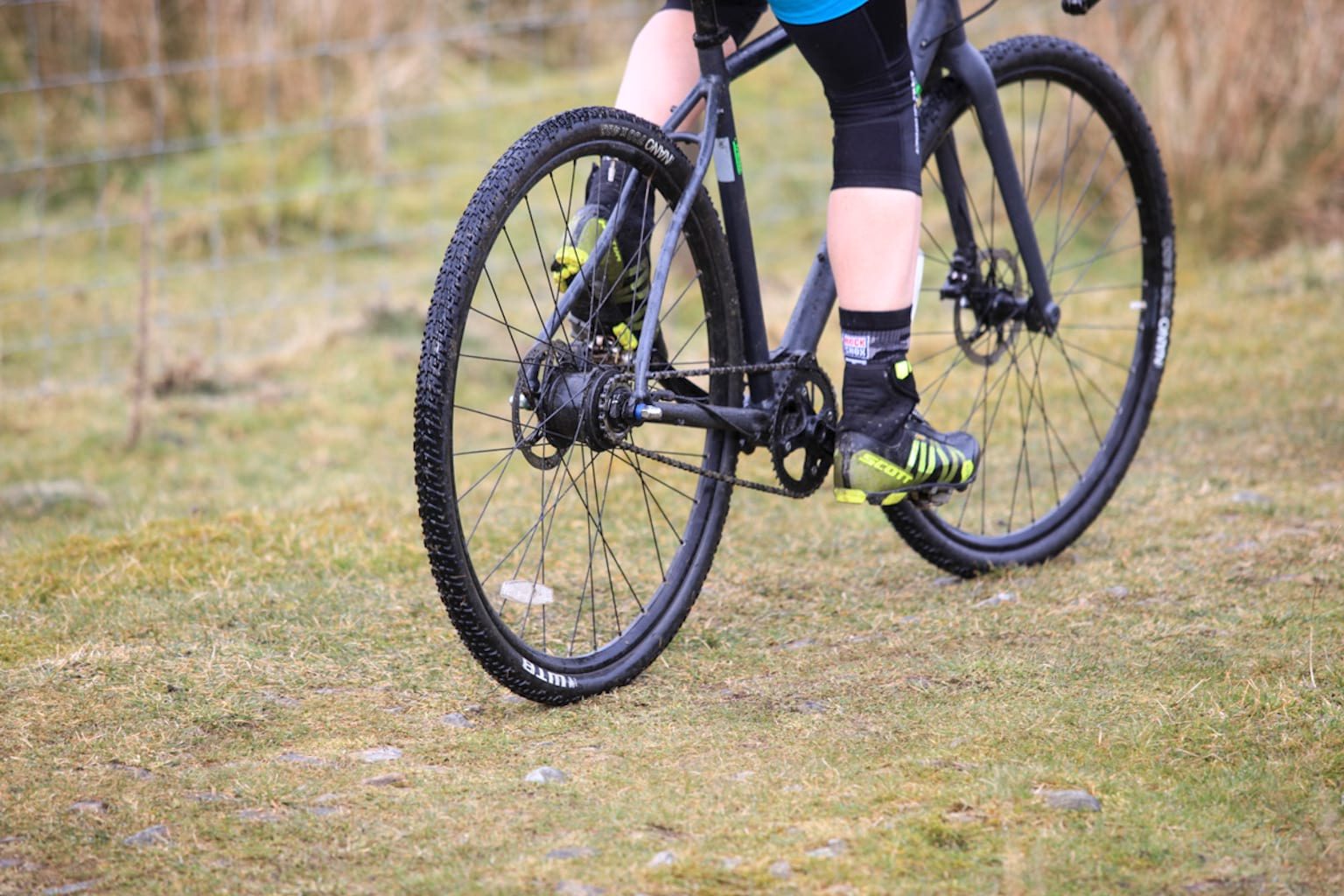
The bar end shifter was effective and took little time to adjust to. Shifting was decisive and I didn’t have any trouble with finding gears. However, I did find that it was rather easy to nudge the shifter with your gear when standing up to climb – either by catching it with your knee, or the end of some baggy shorts. Nudging my way into a harder gear while getting up a steep hill brought me to a halt on more than one occasion. If you’re trying to choose between models, note this same shifter appears on the Arkose X model.
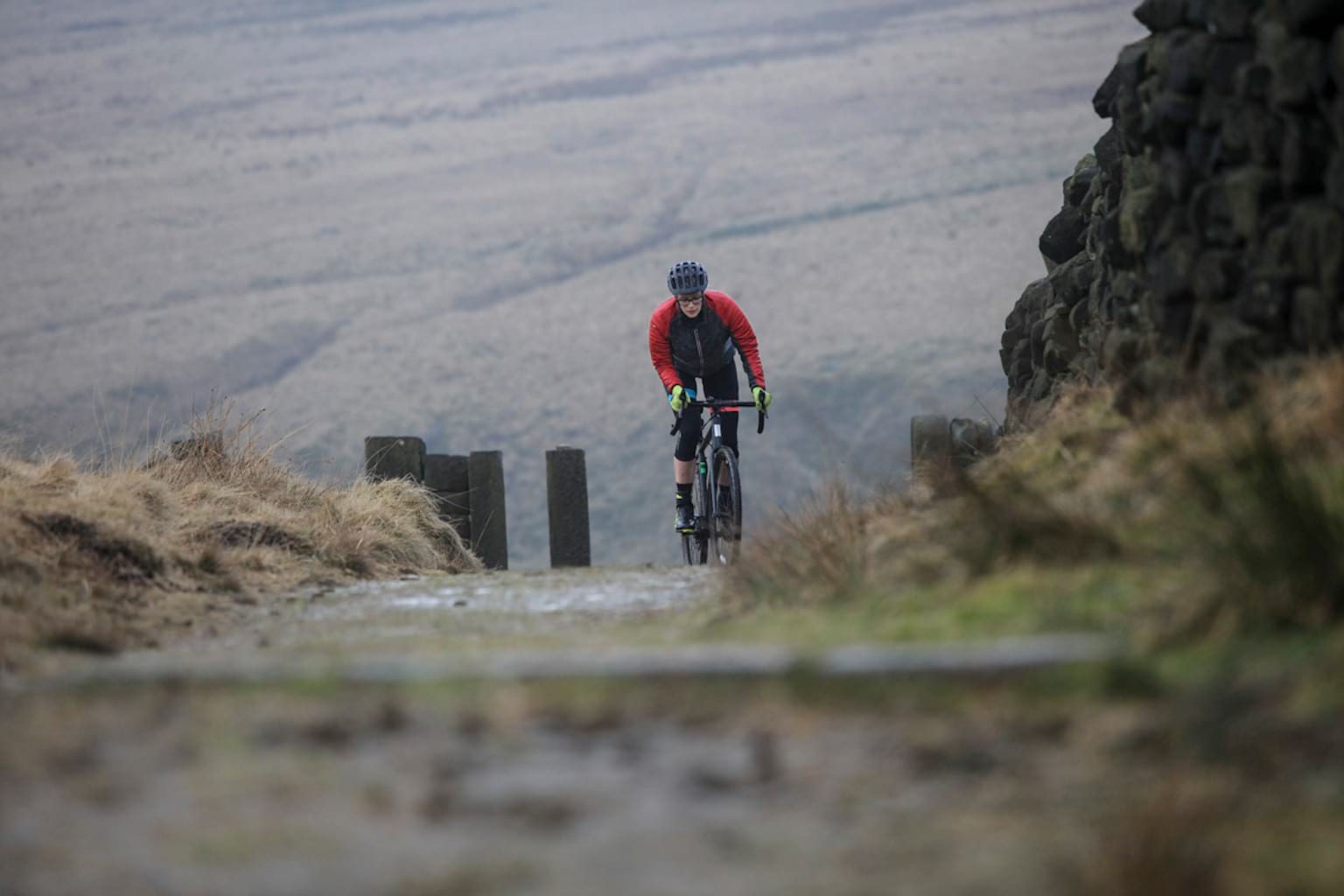
I had wondered whether the 8 speed gears with a 40t chainring and 19t sprocket would offer enough of a range to get me up and down all my usual hills. The answer is that, I could by and large still get up them, however, the hills round here are often of the quite long and rather steep variety, and for a long ride with multiple hills I’d prefer a few more gears. It is more gears I was look for – on the flat the 40/19 combination feels right, and I wouldn’t really want to change that flat terrain gear option to anything easier. I’d also like some more gears for rougher off road climbs – with no sit and spin option I did find myself having to push up some climbs I’d usually ride. But unless you live in the Lake District, you’re probably going to find that for the average commute or even a bit of an adventure ride, you’re going to have enough gears to survive.
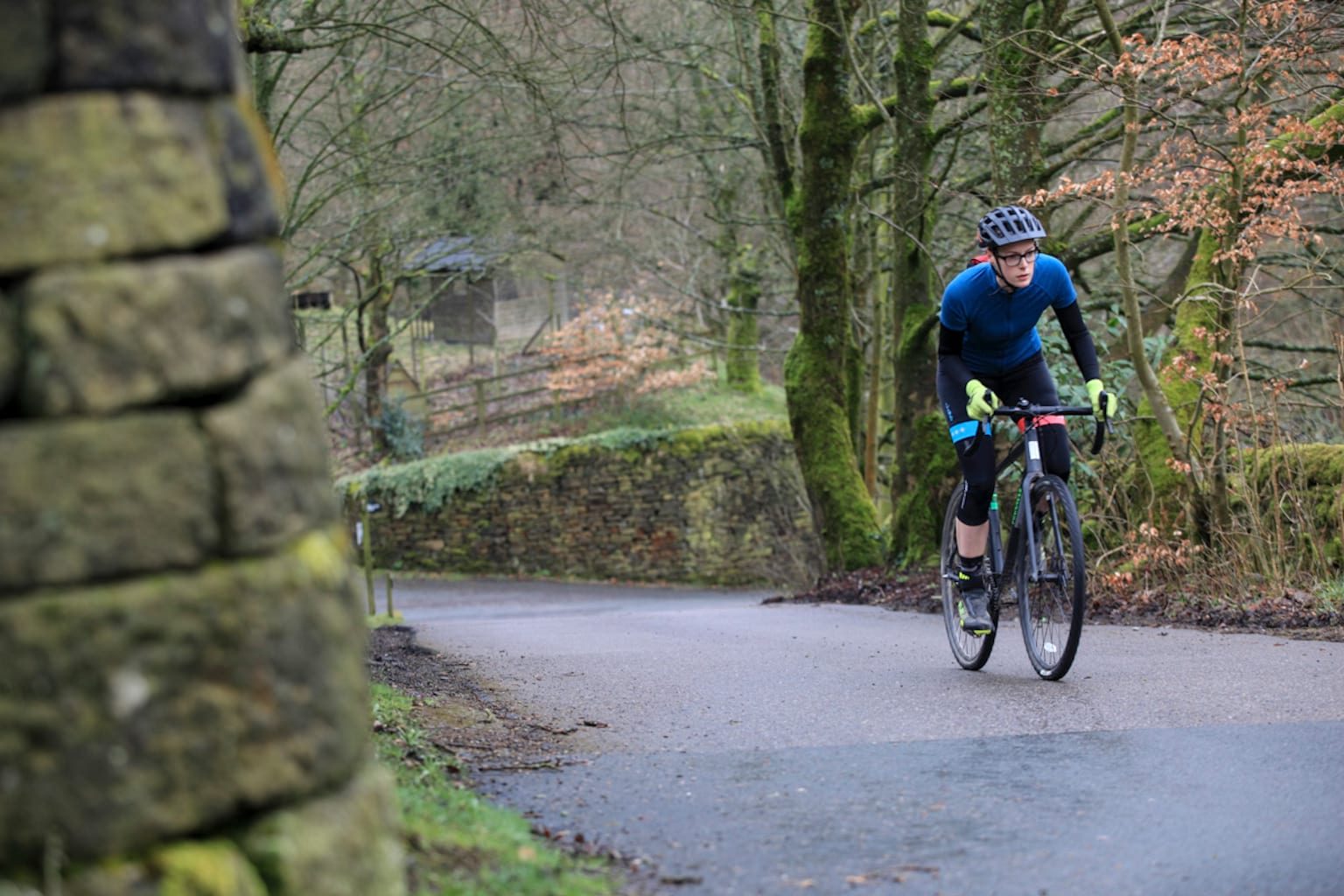
Bearing in mind the Arkose Alfine 8 doesn’t come tubeless ready, and with the hub gears you’d need to build a whole new wheel with new rims in order to make the change to tubeless, fixing a puncture is a little trickier than you might ideally like to be faced with trailside. First up, you need to make sure you have the right tools. You’re going to need 15mm spanners to release the wheel. You could do it with one, but two is probably better. Then you’re going to need something thin and pokey, like a 2mm Allen key to release the shifter cable. None of these are things in my usual multitool set up, so be sure to check that you’re suitably equipped with the tools you hopefully won’t need. For me, this amounts to a bit more trailside faff than I’d like, especially in cold weather, so I’ve been super cautious about my tyre pressures and kept any eye out for things like broken glass.
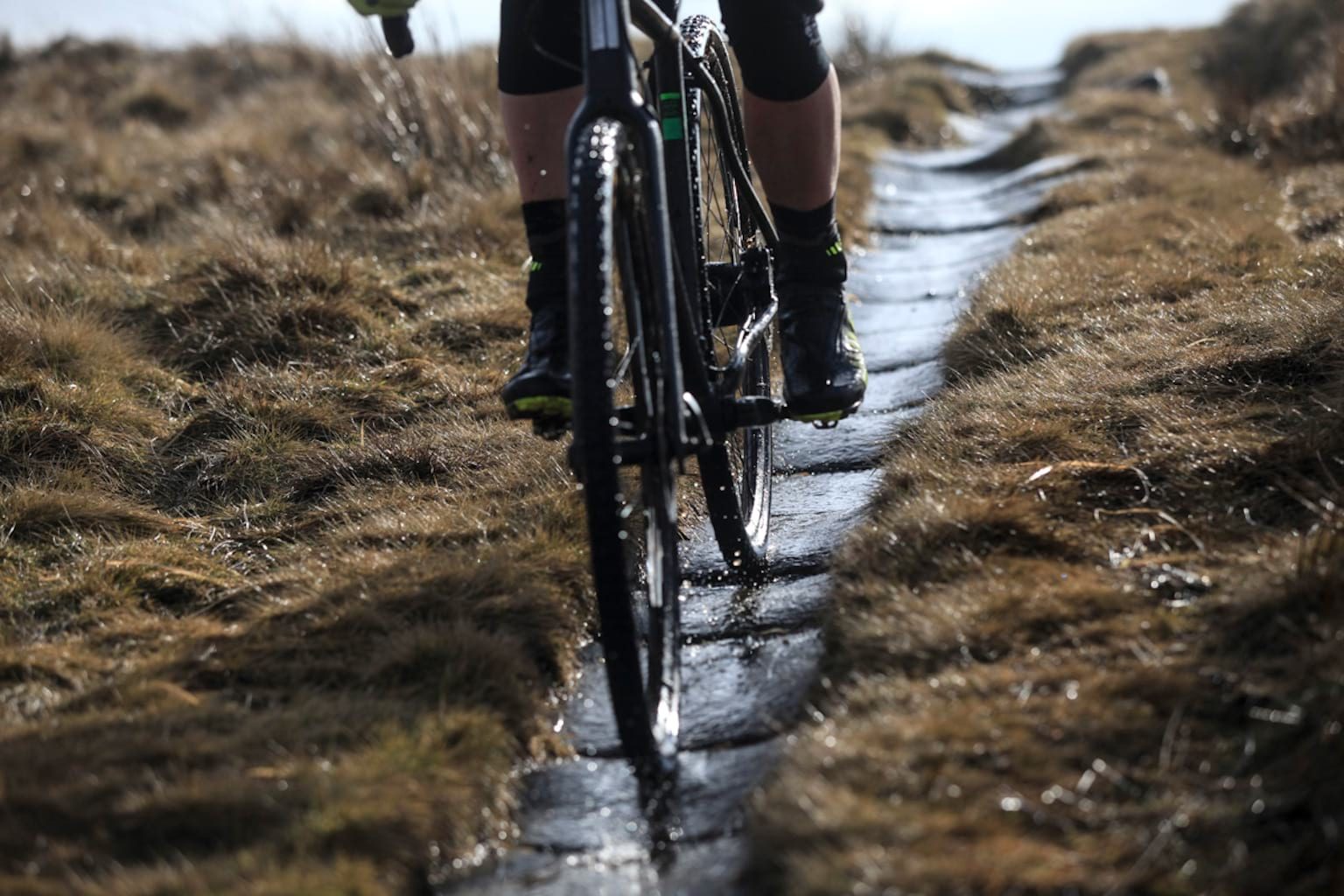
A final point about the Alfine hub is that it is fairly heavy – though the claimed weight of the price point comparator, the Arkose 2 with Tiagra, is actually 100g more than the Alfine version. I don’t think it’s so much the weight itself as the distribution of it that makes it a little noticeable in the handling. It’s quite subtle, but it’s just not quite as playful in the handling as some other bikes I’ve ridden. If you’ve ever put a rack onto your bike and noticed the slight sensation of having a tail, it’s a bit like that – but certainly not like having luggage behind you.
Choices, choices.
With nine models in the range, or six if you discount the women’s models, then there’s a decent amount of choice, and so the question is surely ‘Is the Arkose Alfine 8 the one for me?’. The two closest competitors for your money are probably the Arkose X – a 1x Shimano Deore set up with tubeless compatible wheels at £900 – or the Arkose 2 – the Tiagra model. The X gives you a fashionable 1x system and lighter weight (but with the bar end shifter), while the 2 gives you functional but reliable Tiagra shifting complete with front derailleur and familiar shifters. The basic geometry and specification of the bikes is good – they’re not the lightest and fastest, but they are comfortable and functional, with plenty of scope for swapping out things like tyres for rougher or smoother rides.
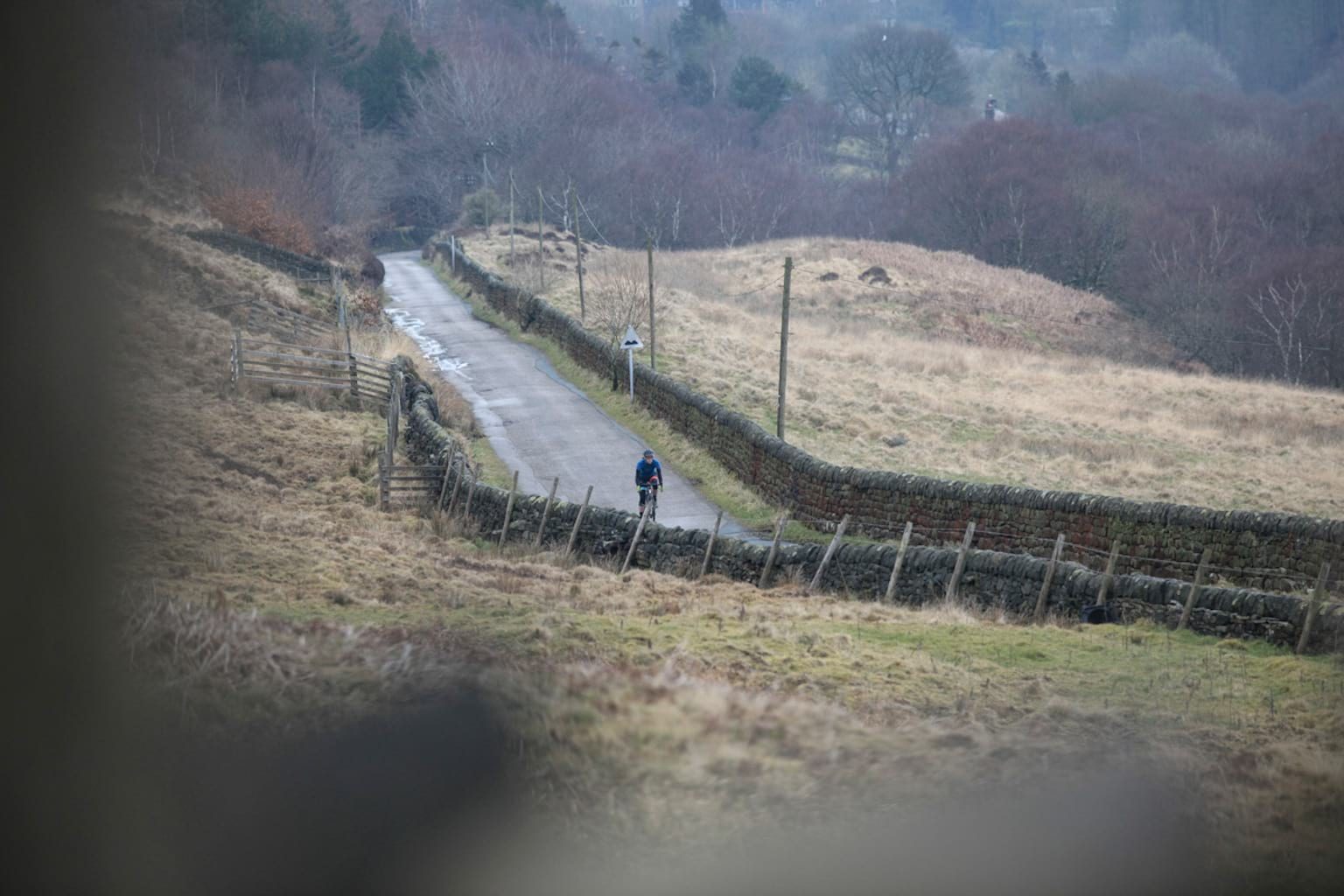
For regular off-the-beaten track riding, I’m not sure the Alfine would be my choice. The lure of ride and forget without endless jockey wheel cleaning is strong, as is the desire for decent sized mudguards (for which there are both clearance and lugs). But, there’s something about its steampunk complexity that puts me off – if it goes wrong, there’s really very little you can do about it trailside. At least with a standard rear derailleur set up you can usually do a bodge of some description to get you home. Although I’m sure its fans will say they’ve done tens of thousands of miles with no trouble, my experience of the Alfine hub has been disappointing and this has coloured my feelings about it. Add into that, the downgraded rims versus the Arkose 2, I think I would personally be looking to other bikes in the Arkose range.
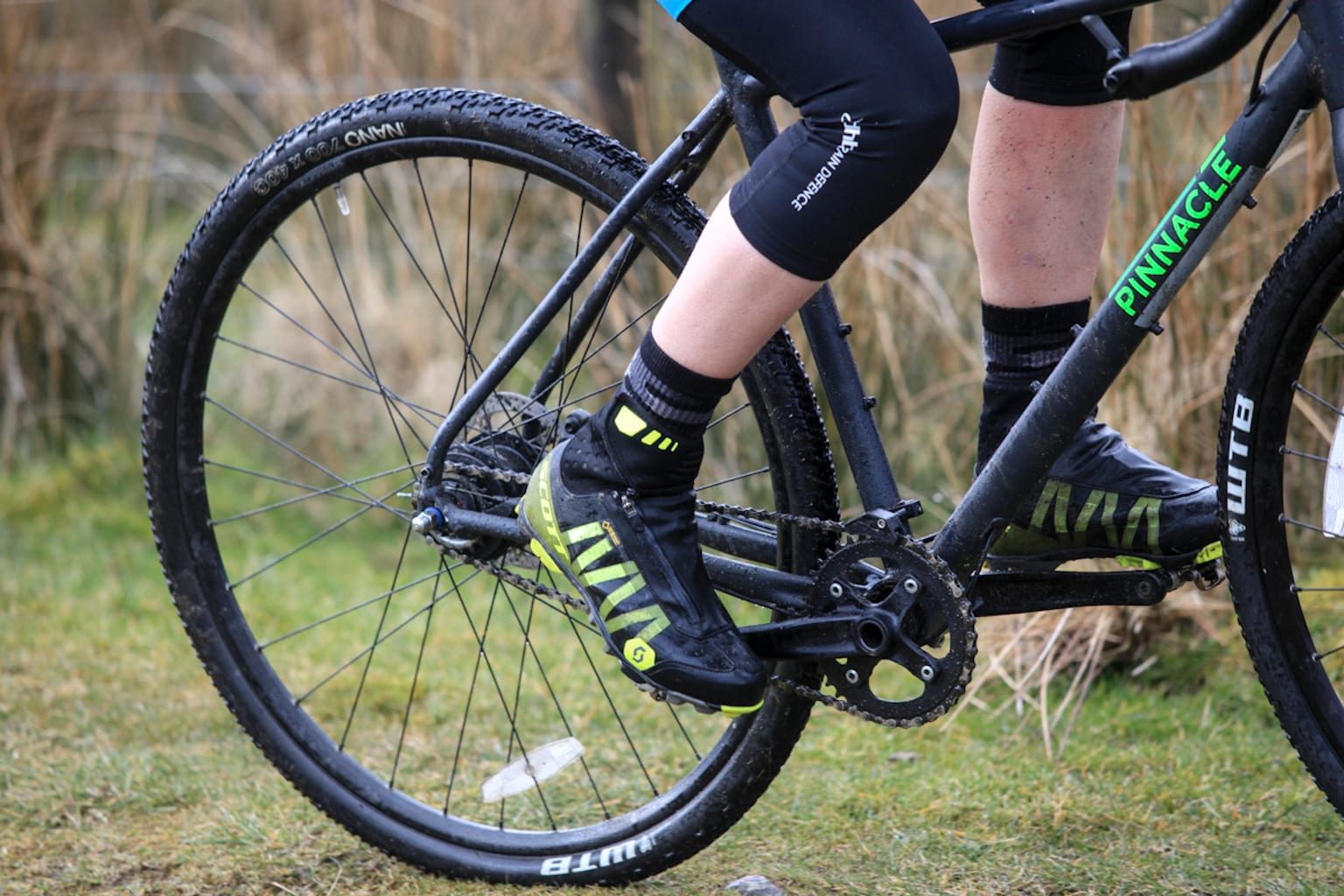
If I was looking for a bike for suburbia to city commutes (rather than into the wilds adventure) then I’d be giving this bike a very close look indeed.
Overall
If you get on with the Alfine 8 hub, this bike is a sound choice for the mixed surface commuter and occasional adventurer. If you’re aiming to use it more aggressively, or instead of a hardtail mountain bike, I suspect a tubeless ready option from elsewhere in the Arkose range is a better choice – and a good one.
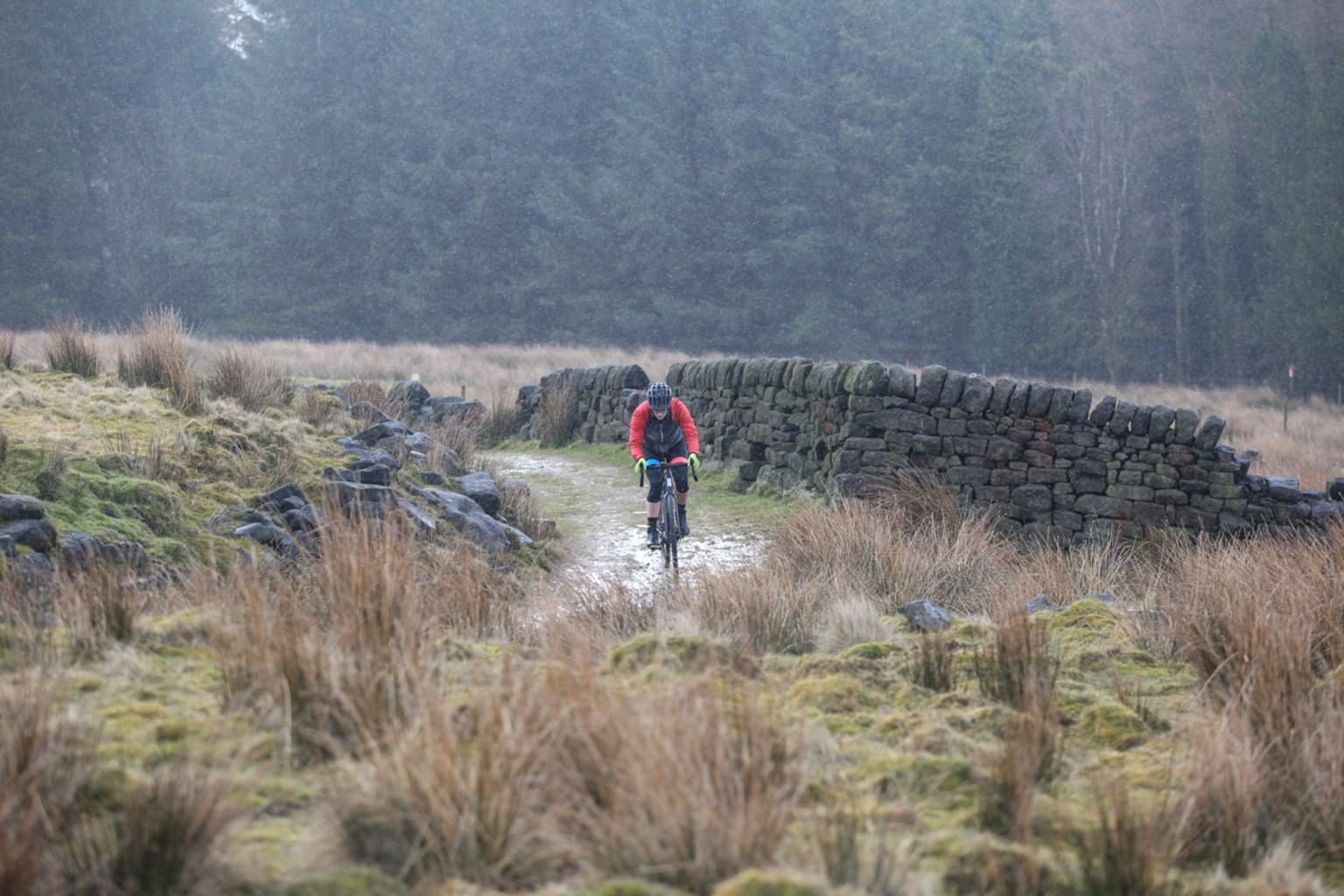






Nice review Hannah and very honest. I’ve wondered about an Aldine hub for a commuter for a few years. I think this has finally answered that. If buying a Pinnacle as a mainly commuter ride I think I’d go for the X and use the £100 for mudguards and perhaps more mixed road/track focused tyres. Something like the WTB Riddler? Thanks for the review. This one has definitely been helpful.